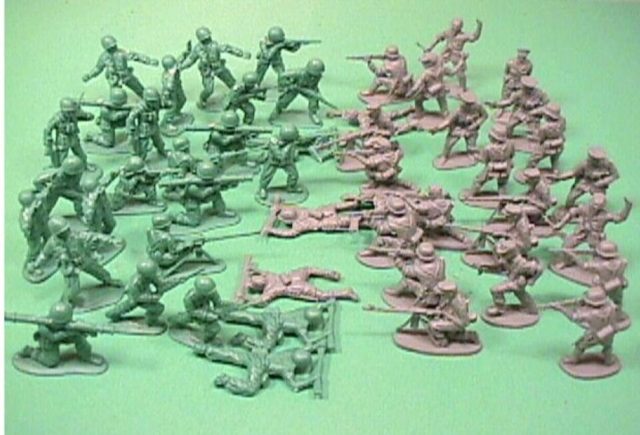“Those who cannot remember the past are condemned to repeat it.”
HOW DO I put this delicately? There seems no other way to say it, but just say it … I was once a Nazi.
Now that you have choked on your morning coffee or swerved into the next lane if you are reading this online while driving – which is a very bad habit, by the way – allow me to explain.
When we were just little children my brother and I used to be obsessed with World War II. It could have something to do with the fact that we had piles and piles of war comics as well as the moulded plastic toy soldiers that we played with constantly. It could also be due to the fact that World War II movies were pretty popular at the time, I don’t know.
Whatever the reason, we were immersed in the ‘glamour’ of the Second World War. Of course, my brother, being older, got to pick his side first, and he picked the Allies (only he called them “the Americans”). I was left with the other team … Germany.
The result of me always being the German was that I became very well acquainted with the German equipment, weapons, uniforms and insignias. And unfortunately, mixed into that paraphernalia and insignias were the SS uniforms, the Nazi flags, banners and emblems.
Not knowing any better, I embraced everything from the German war machine, including the swastika as part of my ‘team’s brand’ … and spent many happy hours representing my army. I even called them – every single plastic soldier I owned – the Nazi army.
It was after quite a number of years that I started learning about what the Nazis did. A documentary series that aired on South African TV in the ’70s, ‘The World at War’, left me quite traumatised as the scales fell from my eyes and I slowly started learning what the Nazi party, under the leadership of Adolf Hitler, had planned and what they had achieved.
Needless to say, my brother would not allow me to change sides in our war games, so I had to still be a German. However, I first decommissioned and dismissed all the Nazis from my ranks.
Then, a few more years on, there was something else that surprised me quite a bit. I learned that in Braunau am Inn, a small medieval town near Austria’s border with Germany, a yellow, three-storey building is actually the place where Adolf Hitler was born.
Apparently, in May 1945, a German platoon tried to blow up the house, and the Americans defended it when they were liberating Braunau. Today, in front of the building a stone memorial to Holocaust victims bears an inscription: “For peace, freedom and democracy. Never again fascism. Millions dead are a warning.”
More surprises were to come. I learned that the concentration camps, where millions of people were inhumanely incarcerated and many millions exterminated, were also still standing. The prison where Hilter wrote Mein Kampf is also still standing.
My teenage brain tried to grasp why these structures were not demolished. Surely having them standing and maintained would be a tremendous source of emotional torment for people who had survived the holocaust.
Someone once told me that these, what he called “dark structures” are left standing to remind the later generations of what happened during the mid-1930s to mid-1940s. Also the dark structures are standing as an ominous warning of what can happen if people forget the lessons of history.
However, in South Africa it seems that we have taken a different approach. Slowly, surely and steadily the footprints and fingerprints of the dark structure of Apartheid is being erased. Towns, cities, roads, bridges, buildings are being renamed, so that we have absolutely no record of the names of those terrible oppressors.
I cannot say that this approach is wrong, who am I to judge? But the fact that they did not change all the names over a predetermined period does rub me up the wrong way. In my imagination I see shops stocking maps having to throw out a pile of maps every few years because they are irrelevant because of these name changes.
Then on Wednesday, I read in an Eastern Cape newspaper that a certain Kanya Mdaka from Engcobo has approached the equality court in East London for a declaration that the use of the Springbok rugby emblem constitutes hate speech, similarly to the display of the apartheid SA flag.
I am not going to wade into this argument. People get too steamed, and asking questions and having an opinion these days opens one to being vilified on social media.
All I want to ask, once again, is that once all the Apartheid footprints and fingerprints are finally erased, once every emblem, badge, banner and flag has been ejected into the stratosphere … does anyone really believe that we will be a happy, contented, united society?
In my personal opinion, we are always going to be at each others’ throats if we focus inward and keep looking at what hurt us in the past, instead of focusing outward and asking what we can do to actually help others in the future?
Spanish philosopher George Santayana is credited with the aphorism, “Those who cannot remember the past are condemned to repeat it.” And it nags me that the young people all around us today will soon have no idea of what our country’s yesterday was like because all our ‘dark structures’ will have been sanitised, and this could threaten their tomorrow.
* The views expressed in this opinion piece are those of the writer, and do not necessarily reflect the views of the DFA.








